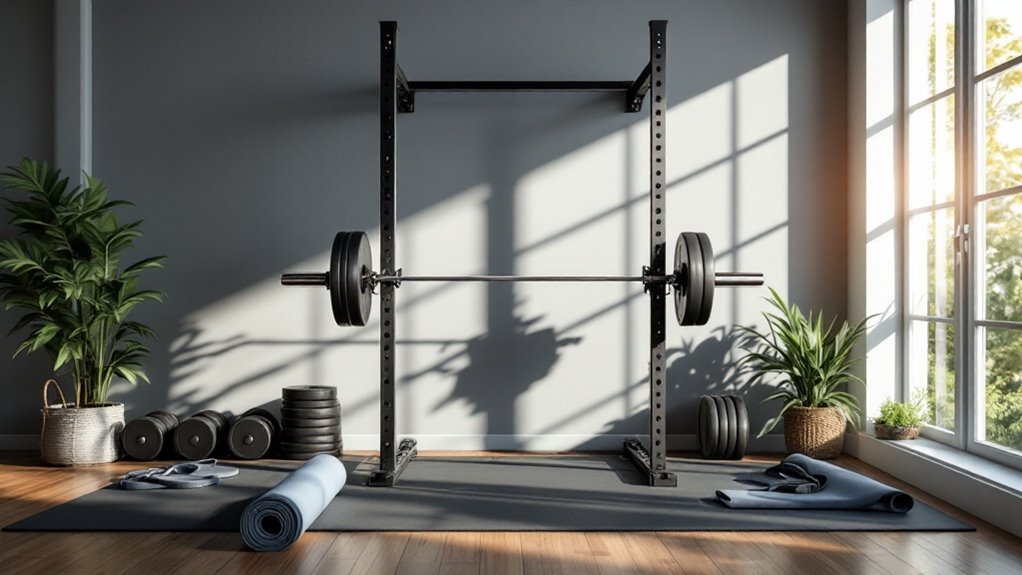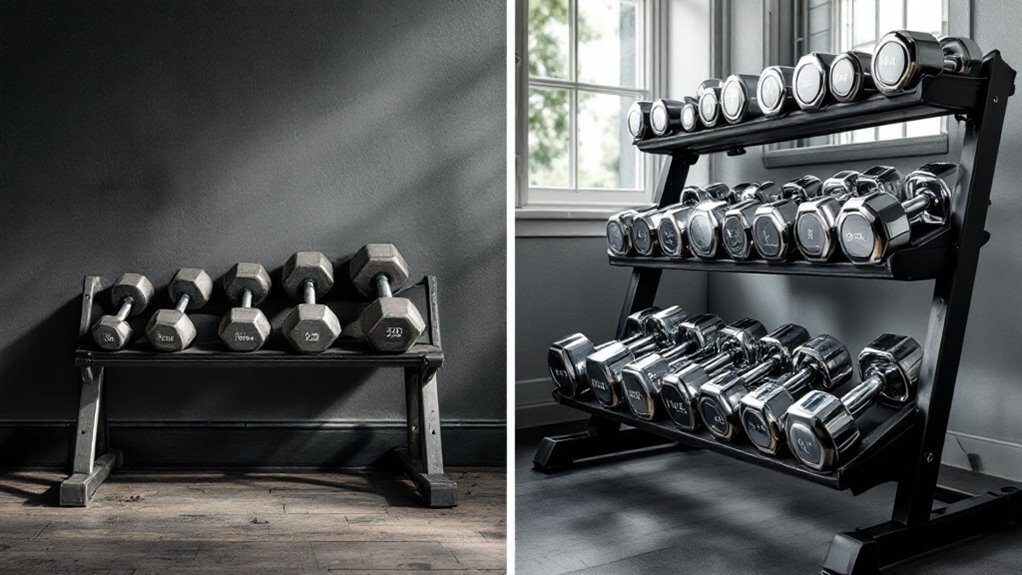Bodybuilding Transformation

A successful bodybuilding transformation demands military-level discipline across four key battlefronts: strategic training, precise nutrition, ideal recovery, and unwavering mental focus. Progressive overload principles guide muscle development through compound exercises and controlled movements. Daily protein requirements of 1.6-2.2g per kg bodyweight, combined with structured meal timing, fuel growth. Quality sleep of 7-9 hours and stress management enhance results. The journey to physical excellence reveals powerful secrets of human potential.
Key Takeaways
- Create a sustainable caloric surplus through nutrient-dense foods while maintaining protein intake between 1.6-2.2g per kilogram of bodyweight.
- Focus on progressive overload in compound exercises with proper form to maximize muscle growth and strength development.
- Get 7-9 hours of quality sleep daily and manage stress levels to optimize recovery and muscle-building hormones.
- Track workouts and nutrition consistently to ensure measurable progress and maintain accountability throughout the transformation journey.
- Establish a structured workout routine combining both compound and isolation exercises with adequate rest between training sessions.
Foundation of a Successful Body Transformation

Initiating a successful body transformation requires building a rock-solid foundation of essential elements working in harmony.
Like constructing a fortress, the foundation must include proper nutrition, consistent training, adequate rest, and unwavering mental fortitude. Each component reinforces the others, creating a framework for sustainable progress.
The transformation journey demands strategic planning and execution, similar to a military operation.
Tracking metrics, maintaining detailed logs, and establishing clear milestones create accountability and momentum.
Success hinges on developing systems that coordinate with individual goals while remaining adaptable to life's demands. This structured approach turns the formidable endeavor of transformation into a series of achievable daily victories.
Incorporating both compound and isolation exercises into your training regimen ensures comprehensive muscular development and optimal strength gains.
Training Principles for Maximum Muscle Growth

When pursuing maximum muscle growth, athletes must embrace fundamental training principles that have stood the test of time.
Progressive overload, proper form, and adequate rest between sets form the cornerstone of effective muscle building. Training volume and intensity must be carefully balanced to stimulate growth while preventing burnout.
Building muscle demands a delicate balance of progressive challenge, meticulous technique, and strategic rest to maximize gains while avoiding exhaustion.
Key principles include compound exercises that target multiple muscle groups, controlling tempo during both concentric and eccentric movements, and maintaining a consistent mind-muscle connection.
Strategic rest periods between workouts allow for proper recovery and adaptation, while varying rep ranges and exercise selection prevents plateaus.
Success comes from disciplined application of these proven methods.
Proper nutrition and supplementation play vital roles in supporting muscle development and recovery.
Nutrition Strategies for Building Lean Mass

Proper nutrition serves as the foundation for building quality lean mass, working in perfect harmony with strategic training principles.
A structured approach to caloric surplus, combining lean proteins, complex carbohydrates, and healthy fats, creates the ideal environment for muscle growth.
Athletes must consume 1.6-2.2 grams of protein per kilogram of body weight daily, timing meals strategically around workouts. Complex carbohydrates fuel intense training sessions while maintaining steady energy levels. Essential fatty acids support hormone production and recovery.
Meal preparation and consistent timing create the metabolic framework necessary for sustained muscle development. Regular nutrient-dense feedings, spaced 3-4 hours apart, enhance protein synthesis and energy utilization.
Following progressive overload principles alongside proper nutrition ensures continuous muscle adaptation and growth.
Recovery and Lifestyle Optimization

Successful bodybuilding transformations rely heavily on strategic recovery methods and lifestyle optimization techniques that extend far beyond the gym walls.
Quality sleep, stress management, and proper hydration form the foundation of effective recovery. Athletes must prioritize 7-9 hours of uninterrupted sleep, implement meditation or relaxation practices, and maintain consistent sleep-wake cycles.
Lifestyle factors like time management, social support systems, and work-life balance play vital roles in sustaining long-term progress.
Successful bodybuilders organize their daily schedules around training and meal times while eliminating habits that hinder recovery, such as excessive alcohol consumption or irregular eating patterns.
Incorporating daily exercise routines can significantly enhance cardiovascular health while supporting muscle development and overall fitness goals.
Frequently Asked Questions
How Long Does It Take to See Visible Muscle Definition?
Muscle definition becomes visible within 4-8 weeks of consistent training and proper nutrition, assuming a body fat percentage under 15% for men and 22% for women.
Key factors include training intensity, diet quality, rest, and genetics.
For beginners following structured programs, initial muscle tone appears around week 6, with more pronounced definition developing over 3-6 months of dedicated effort.
Should I Train if I'm Feeling Sick or Have Minor Injuries?
Training while sick or injured can worsen conditions and delay recovery.
Minor injuries need proper rest to prevent escalation into major problems. For illnesses, the general rule is: working out is acceptable if symptoms are above the neck (mild cold), but not below (chest congestion, fever).
However, reducing intensity by 50% and listening to your body's signals is essential for safe training continuation.
Can I Build Muscle and Maintain a Social Life?
Building muscle and socializing aren't mutually exclusive – thousands of successful bodybuilders maintain thriving social lives.
Smart time management is key: schedule workouts during off-peak social hours, meal prep in advance, and combine fitness with social activities.
Train early mornings or during lunch breaks, organize active meetups with friends, and remember that consistency, not isolation, builds results.
Balance creates sustainable lifestyle changes.
Do Genetics Play a Significant Role in Muscle-Building Potential?
Genetics influence muscle-building potential through factors like muscle fiber composition, hormone levels, and skeletal frame size.
However, they're not destiny. Research shows that proper training and nutrition can help anyone build significant muscle mass, regardless of genetic predisposition.
While some may progress faster or achieve greater maximum potential, dedication and consistent effort remain the primary drivers of muscle development success.
What Supplements Are Essential for Someone Allergic to Whey Protein?
For those with whey allergies, essential supplements include plant-based protein powders (pea, rice, hemp), creatine monohydrate for muscle recovery and strength, BCAAs to prevent muscle breakdown, vitamin D3 for hormone regulation, and omega-3 fatty acids for inflammation control.
Casein protein alternatives and EAAs can support muscle growth. A high-quality multivitamin guarantees micronutrient needs are met during training phases.
Final Thoughts
Like a phoenix rising from the ashes, a successful bodybuilding transformation requires unwavering dedication to foundational principles. Through scientifically-proven training methods, precision nutrition, and ideal recovery practices, anyone can sculpt their ideal physique. Just as Michelangelo saw David within the marble before carving began, visualizing and pursuing your physical potential with discipline and patience will eventually reveal your masterpiece.


